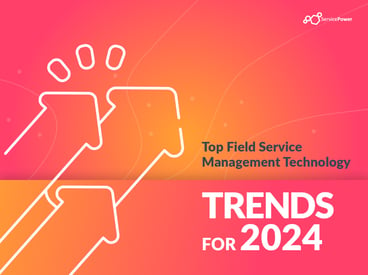How to Achieve Service Excellence with Customer Self-Service
In the field service industry, most companies aim to delight their customers by providing service excellence. While this may sound simple enough,...
2 min read
 ServicePower
:
February 28, 2024
ServicePower
:
February 28, 2024

Check out the Top Field Service Management Technology Trends for 2025 here.
As we continue our series on the technology trends that will likely be in the 2024 spotlight, next up is trend: #4: customer self-service.
#4 Customer Self-Service
Providing self-service abilities is a vital part of the overall positive experience customers expect of field service organizations (FSOs) today. This trend will continue to be a driving force in field service in 2024, with organizations increasingly turning to technology to help them provide effective tools and channels for engaging with customers. The solutions will need to meet the needs of both customers and technicians, providing the right blend of flexibility, collaboration, and efficiency. Fortunately, software providers are up to the challenge.

Big expectations
Customers still expect all the usual qualities of responsive field service—from a narrow arrival window to resolution on the first visit. They want a technician who is knowledgeable and able to explain the repair strategy, demonstrating due diligence and tactics that provide the best fix at the lowest cost.
But, while customers appreciate meaningful dialogue with the service technician on location, they also see the value in self-service before the time of dispatch. Scheduling repair times themselves are recognized as a time-saver—and can be conducted at the customer’s convenience, any time, from anywhere. Consumers have become adept at communicating through digital channels and online portals and often prefer rapid fact-focused exchanges over interactions with humans, especially if there is a long wait, multiple call transfers, or being connected to an off-shore agent.
The customer knows best
Consumers today want to control when and how they engage with suppliers, installers, and service providers. They are ultra-protective of their personal time and resent needing to wait in a queue for the next available agent or miss a day of work waiting for the service technician to arrive.
An online portal provides the self-service flexibility consumers want. Customers can submit a service request, explain the issue, and confirm the day and time for the service call. Customers can also cancel or make changes to the schedule if needed. Technicians can communicate if they are running late and provide updates on arrival times. An online tool for real-time communication is the most effective way for the customer and service technicians to coordinate and align. This direct communication between the customer and technician saves the call center agents and dispatchers from numerous back-and-forth calls, allowing them to focus on new service requests.
A modern online portal also provides the organization opportunities to reinforce their brand and communicate special promotions, coupons, or value messaging.
Benefits add up
Service-centric organizations that have adopted online portals report numerous benefits, including significant improvements to their Net Promoter Scores (NPS), better customer retention, increased revenue per customer, and reduced call center volume. First-call resolution rates also tend to climb, as scheduling conflicts can be worked out before the technician wastes a trip only to find the homeowner is not there.
Using technology, like an online portal, helps keep customers happy and loyal. Customer satisfaction leads to long-term customer retention, which, in turn, helps drive corporate profitability.
“It's also easier and more cost-effective to retain customers than to acquire new ones, returning customers spend more and buy more often and refer friends and family. Only a 5% increase in customer retention can increase company revenue by 25-95%,” says HubSpot. The research report goes on to say it's 6 to 7 times more expensive to acquire a new customer than it is to retain an existing customer and repeat customers buy more often and spend more than newer customers. Satisfied, loyal customers also are more likely to make referrals.
Final takeaway
Providing self-service tools, like an online portal, is an important step toward pleasing customers and building long-term customer loyalty that will pay off. You can learn more about ServicePower’s customer self-service capabilities here.
Read the complete Top Field Service Management Technology Trends for 2024 report here.

In the field service industry, most companies aim to delight their customers by providing service excellence. While this may sound simple enough,...

1 min read
Consumers today have high expectations of services and products and want to be empowered by self-service technology (often through mobile platforms)....

Enabling a comprehensive, frictionless customer experience is an integral aspect of field service management and it often plays a large role in...